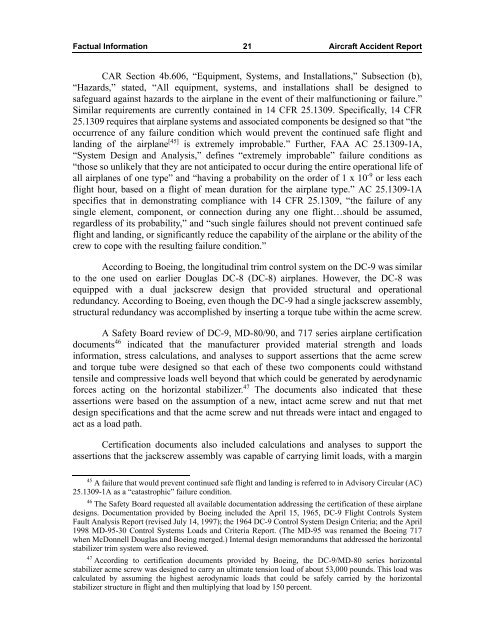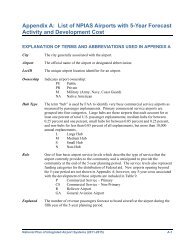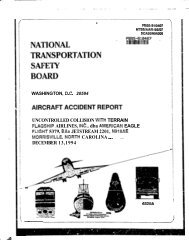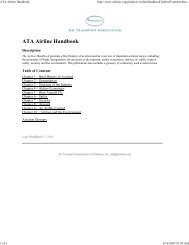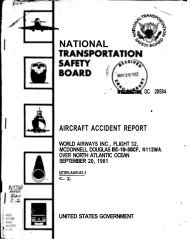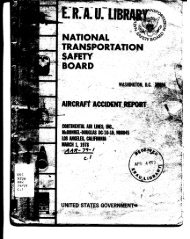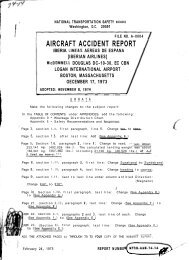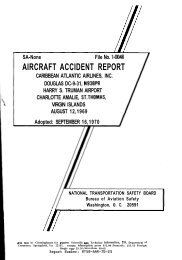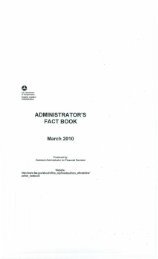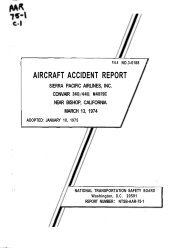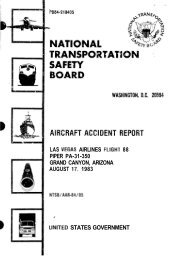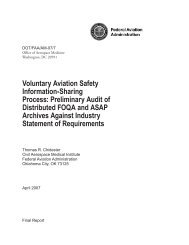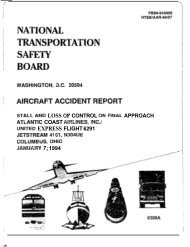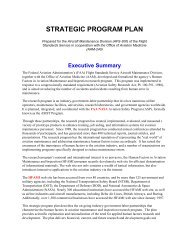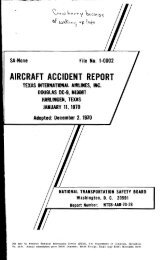NTSB/AAR-02/01
NTSB/AAR-02/01
NTSB/AAR-02/01
Create successful ePaper yourself
Turn your PDF publications into a flip-book with our unique Google optimized e-Paper software.
Factual Information 21 Aircraft Accident Report<br />
CAR Section 4b.606, “Equipment, Systems, and Installations,” Subsection (b),<br />
“Hazards,” stated, “All equipment, systems, and installations shall be designed to<br />
safeguard against hazards to the airplane in the event of their malfunctioning or failure.”<br />
Similar requirements are currently contained in 14 CFR 25.1309. Specifically, 14 CFR<br />
25.1309 requires that airplane systems and associated components be designed so that “the<br />
occurrence of any failure condition which would prevent the continued safe flight and<br />
landing of the airplane [45] is extremely improbable.” Further, FAA AC 25.1309-1A,<br />
“System Design and Analysis,” defines “extremely improbable” failure conditions as<br />
“those so unlikely that they are not anticipated to occur during the entire operational life of<br />
all airplanes of one type” and “having a probability on the order of 1 x 10 -9 or less each<br />
flight hour, based on a flight of mean duration for the airplane type.” AC 25.1309-1A<br />
specifies that in demonstrating compliance with 14 CFR 25.1309, “the failure of any<br />
single element, component, or connection during any one flight…should be assumed,<br />
regardless of its probability,” and “such single failures should not prevent continued safe<br />
flight and landing, or significantly reduce the capability of the airplane or the ability of the<br />
crew to cope with the resulting failure condition.”<br />
According to Boeing, the longitudinal trim control system on the DC-9 was similar<br />
to the one used on earlier Douglas DC-8 (DC-8) airplanes. However, the DC-8 was<br />
equipped with a dual jackscrew design that provided structural and operational<br />
redundancy. According to Boeing, even though the DC-9 had a single jackscrew assembly,<br />
structural redundancy was accomplished by inserting a torque tube within the acme screw.<br />
A Safety Board review of DC-9, MD-80/90, and 717 series airplane certification<br />
documents 46 indicated that the manufacturer provided material strength and loads<br />
information, stress calculations, and analyses to support assertions that the acme screw<br />
and torque tube were designed so that each of these two components could withstand<br />
tensile and compressive loads well beyond that which could be generated by aerodynamic<br />
forces acting on the horizontal stabilizer. 47 The documents also indicated that these<br />
assertions were based on the assumption of a new, intact acme screw and nut that met<br />
design specifications and that the acme screw and nut threads were intact and engaged to<br />
act as a load path.<br />
Certification documents also included calculations and analyses to support the<br />
assertions that the jackscrew assembly was capable of carrying limit loads, with a margin<br />
45 A failure that would prevent continued safe flight and landing is referred to in Advisory Circular (AC)<br />
25.1309-1A as a “catastrophic” failure condition.<br />
46<br />
The Safety Board requested all available documentation addressing the certification of these airplane<br />
designs. Documentation provided by Boeing included the April 15, 1965, DC-9 Flight Controls System<br />
Fault Analysis Report (revised July 14, 1997); the 1964 DC-9 Control System Design Criteria; and the April<br />
1998 MD-95-30 Control Systems Loads and Criteria Report. (The MD-95 was renamed the Boeing 717<br />
when McDonnell Douglas and Boeing merged.) Internal design memorandums that addressed the horizontal<br />
stabilizer trim system were also reviewed.<br />
47 According to certification documents provided by Boeing, the DC-9/MD-80 series horizontal<br />
stabilizer acme screw was designed to carry an ultimate tension load of about 53,000 pounds. This load was<br />
calculated by assuming the highest aerodynamic loads that could be safely carried by the horizontal<br />
stabilizer structure in flight and then multiplying that load by 150 percent.


